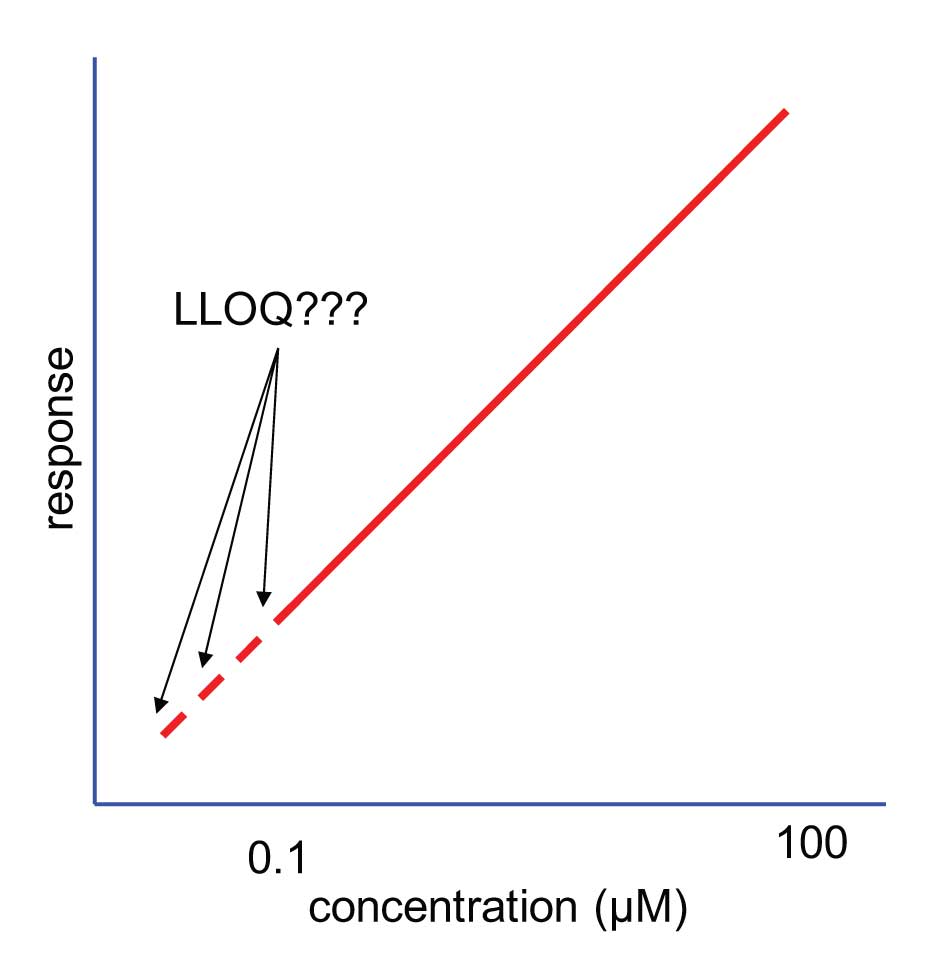The following question was submitted by one of the readers of HPLC Solutions.
Q: I have a question about reporting the limits of my LC-MS/MS method. For this bioanalytical method (a compound extracted from eye tissue) the lowest concentration on the standard curve is 0.01 µM. The curve is made by spiking naïve eye tissue with the compound and extracting it before analysis. It is not a purchased compound, but is an endogenous compound which we’ve synthesized and use in our studies. All samples measured have higher concentrations than 0.01 µM, so it does not need to be lowered in order to bracket our samples properly. My question is, because I routinely detect this lowest standard and have a S/N of 33 at that level, can I call this my LLOQ? Does an LLOQ have to have a signal-to-noise of 10?
JWD : You are very fortunate that your samples do not challenge the lower end of the calibration curve. The lower limit of quantification (LLOQ) generally is defined as the lowest concentration that you can quantify the compound of interest within the acceptable variability of the method. For bioanalytical (drugs in biological matrices) methods by LC-MS/MS, the nominal variability allowed is ±20% at the LLOQ and ±15% at all concentrations above the LLOQ. The result of this limit of ±20% is that a signal-to-noise ratio (S/N) ≈10 is allowed, as noted below. And because most people are trying to quantify as small concentrations as possible, S/N = 10 usually is the target for LLOQ.
 Figure 1
Figure 1
The estimate of the influence of S/N on the imprecision of the method can be made based on:
CVT = (CV12 + CV22 + … + CVS/N2+ … + CVn2)0.5 (1)
where the overall coefficient of variation, CVT, is the square-root of the sum-of-squares of the CVs of all the contributing factors (1, 2, S/N, etc.). In order for a given contribution to have minor influence on the overall CVT, it should be ≤0.5 CVT. This means for a target CVT = 20%, no individual contribution should be ≥10%. However, we never want to validate a method at the acceptance limit – rather we would like to target a value of about half the limit, or CVT ≈ 10% in this case. We can further estimate the CVS/N from:
CVS/N ≈ 50 / (S/N) (2)
where S/N is the signal divided by the peak-to-peak noise. So if the S/N = 10, CVS/N ≈ 5%, keeping its influence low for a method with target CVT ≈ 10%. However, there is no reason that you cannot choose a LLOQ with S/N >10. You can choose 0.01 µm as your LLOQ with S/N = 33 without any penalty. According to equation 1, this would potentially allow the overall imprecision to be <10%, but it is likely if you have a large S/N, something else, such as sample preparation or some other variable, will become the limiting factor.
So the bottom line is that there is no reason to go to the extra work of extending the range to lower concentrations – set the LLOQ = 0.01 µM and smile!
This blog article series is produced in collaboration with John Dolan, best known as one of the world’s foremost HPLC troubleshooting authorities. He is also known for his research with Lloyd Snyder, which resulted in more than 100 technical publications and three books. If you have any questions about this article send them to TechTips@sepscience.com




